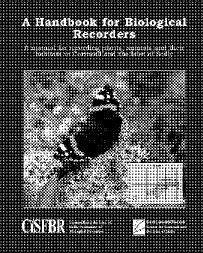HELPING YOU TO HELP WILDLIFE
A Handbook for Biological Recorders
has been designed to help people who are interested in recording the plants
and animals they see in Cornwall and the Isles of Scilly, including in
the waters around our coast. The handbook begins with some introductory
sections about recording in general: what and how to record; how to take
a grid reference; how to design a recording study; and what you should
do with records once you have collected them. The majority of the handbook
then goes on to deal with individual plant and animal groups. The species
covered include many different groups from fungi, lichens, byrophytes
and vascular plants, through a wide range of invertebrates, to fish, amphibians,
reptiles, birds and mammals. The last seven sections deal with various
aspects of marine recording, covering groups such as marine fish, seals,
whales and dolphins. The handbook has been designed in a loose-leaf format
within an A4 folder by the Cornwall and Isles of Scilly Federation of
Biological Recorders (CISFBR) and the Records Centre. It is available
from the Records Centre, priced at £12.00 (or £10.00 if you
are a member of CISFBR) plus £4.70 postage and packing.
There are various special interest
recording groups within Cornwall and the Isles of Scilly, many of which
were set up with the elements of recording and monitoring particular species
and their associated habitats in mind. These include the Cornwall Bat
Group, Cornwall Mammal Group, Cornwall Butterfly Conservation and Cornwall
Bird Watching and Preservation Society, to name but a few (contact details
for groups can be obtained from ERCCIS).
The Environmental Records Centre for
Cornwall and the Isles of Scilly (ERCCIS) acts as a focus for the collation,
management and provision of local wildlife and geological information.
It was set up in 1997 and builds on the tremendous work of the Cornish
Biological Records Unit and the Data Management Unit of the Cornwall Wildlife

Trust. Information about species, habitats
and sites is collected mainly by volunteer specialists and sent to the
Records Centre where it is checked for accuracy and entered into the computer
database in a standard format. Anyone can ask us at the Records Centre
for information relating to the wildlife and geology of Cornwall and the
Isles of Scilly. Increasingly the database is being used to answer enquiries
about the presence of certain species at particular localities, or the
range of locations where a species has been found, and to evaluate the
status of species and the importance of individual sites in relation to
the rest of the county and the islands.
ERCCIS can help you by:
· providing you with information
about the wildlife in your local patch;
| · putting you in touch with the appropriate | |
| individual, group or organisation for a | |
| particular species, habitat or other interest; | |
| · providing information on the whereabouts | |
| and distribution of a particular species | |
| within Cornwall and the Isles of Scilly; | |
| · providing a place to research a particular | |
| natural history or conservation topic using | |
| our reference books, journals and other | |
| sources of information; | |
| · providing training in the identification of | |
| particular species; to date we have run | |
| workshops on ferns and brambles, and how | |
| to survey for semi-aquatic mammals (signs | |
| along the river bank); | |
| · providing information and advice on | |
| different computer software to help with | |
| storing and using the records you collect; | |
| · keeping you up to date with the activities of | |
| the Records Centre through our biannual | |
| newsletter, Kovadha Kernow; if you would | |
| like to receive a copy (free of charge) | |
| please contact us. | |
TELL US WHAT YOU'VE SEEN ...
WHAT you saw
Common name: .............................................................. Scientific
name: ................................................................ Number
seen: ..................................................................
WHERE you saw it
Location name: ................................................................ (please
give site name or closest landmark)
| Grid reference: ................................................................ | |
| Habitat: ............................................................................. | |
| WHEN you saw it | |
| Date: .................................................................................. | |
| Time of day: ..................................................................... | |
WHO you are!
Your name(s): ...................................................................
Your address: ................................................................... Your
telephone number: ...............................................
Would you like to receive
a copy of our Records Centre newsletter (free of charge)? Yes/No